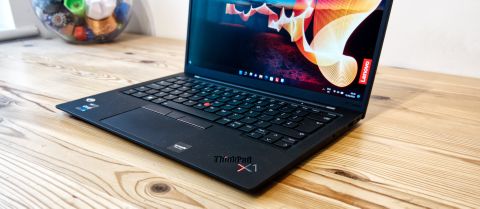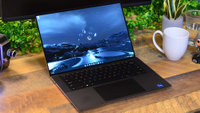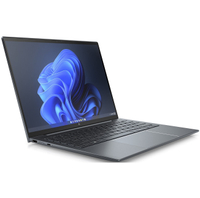TechRadar Verdict
The Carbon X1 reveals the ongoing battle designers are engaged in to balance their performance versus battery use equation. The 2022 model is undoubtedly a more powerful platform but comes with shorter battery life than the machine it replaces.
Pros
- +
Classic styling
- +
Powerful processors
- +
Thunderbolt 4 ports
- +
Gorgeous screen
Cons
- -
Expensive
- -
Needed more battery life
- -
Soldered memory
Why you can trust TechRadar
Lenovo ThinkPad X1 Carbon Gen 10: Two minute review
In the Lenovo ThinkPad range, the X1 Carbon Gen 10 is cleverly pitched to businesses looking to spend decisively on hardware but aren’t ready to indulge their staff with expensive mobile workstations.
That might suggest that this is a more affordable machine, but it’s still a significant chunk of change to blow on equipment that could easily be trashed by careless handling.
Where there was more commonality between the previous X1 Carbon and its predecessor, this hardware is almost an entirely new machine where every aspect has been either uprated or replaced.
Gone is the 16:9 ratio panel to be replaced with a new 14-inch 16:10 ratio, one that can be OLED or even 4K, and even the cheaper display has a better than 1080p resolution.
We also noticed that the webcam is now better with 1080p up from 720p, and the previous generation of this product had a proprietary docking station adapter, and that’s been ditched because Thunderbolt docks are much more popular now.
But the significant difference here is the new Intel mobile chip series that tries to erase the lacklustre history of the previous two or three generations.
However, the new silicon has a distinctly different balance in terms of performance and efficiency, and the available battery doesn’t take you as many hours into a working day as it previously might.
For those with mains power or a means to charge on the move, this isn’t a huge problem, but those that expect to get through an entire working day without charging may be disappointed.
What you get in return for less battery life is a powerful platform that can handle even the most challenging office applications with aplomb. The only performance weakness is that Intel’s Iris Xe integrated GPU doesn’t make the X1 Carbon ideal for video editing or CAD applications, even if it's better than the horrible UHD Graphics that came before.
While there have been numerous changes, what remains is the core ThinkPad aesthetic first defined by IBM more than thirty years ago. It’s a signature feature, even if fewer people use the red nub controller these days, and the company became owned by a different multinational more than seventeen years ago.
Lenovo ThinkPad X1 Carbon Gen 10: Price and availability
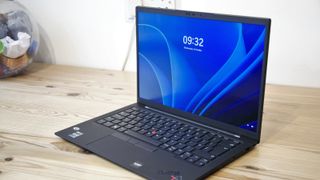
- How much does it cost? From $1,280 / £1,550 / AU$ 2,400
- When is it out? It is available now
- Where can you get it? You can get it in the US, UK, and across Europe
Here is the Lenovo ThinkPad X1 Carbon Gen 10 (2022) configuration sent to TechRadar for review:
CPU: Intel Core i7-1260P Processor (3.4GHz base and 4.5GHz boost)
Graphics: Intel Iris Xe Graphics
RAM: 16GB DDR4 RAM
Screen: 14″ 2880 x 1800 OLED Display
Storage: Samsung PM9A1 512 GB PCIe SSD Gen 4
Ports: 2x USB Type-C Thunderbolt 4, 2x USB Type-A 3.2 Gen 1, 1x HDMI 2.0b, 1x 3.5mm Headphone/Mic combo, 1x Nano SIM slot (Optional)
Connectivity: WiFi 6E, Bluetooth v5.2
Camera: Front-facing 2MP Camera
OS: Windows 11 Pro
Weight: 1.12 kg (2.48 lbs)
Size: 315.6 x 221.5 x 14.9mm (W x D x H)
Battery: 57Whrs 4-cell Lithium-ion Battery with 65W AC Adaptor
The start price for the X1 Carbon seems reasonable until you realise that the base cost is for the model with a Core-i5 class processor, 16GB of RAM, an IPS screen with a resolution of 1920x1200 and no 5G capability.
To buy the hardware as specified in our review is over double that amount, taking the UK price to £3,023.99 and the USA cost to $2,330. One oddity of the US SKUs is that the CPU in the review hardware only comes with 16GB of RAM in the USA, and to get 32GB requires the i7-1270P or higher to be chosen. All memory is soldered to the board, so it isn’t like a user could add the extra RAM to a lower-specified machine.
It's also worth noting that the 4K display isn’t currently an option in the UK, and neither is the i7-1280P vPro processor, though both these are options in other regions.
Overall, with all the possible boxes ticked, this can be a very expensive laptop.
- Value: 3 / 5
Lenovo ThinkPad X1 Carbon Gen 10: Design

- Lightweight carbon fibre and magnesium
- Signature ThinkPad features
- Good port selection
As you get older, picking up a laptop by the corner can provide a moment of panic where your wrist joint considers declining the opportunity to support that lever.
For those that have experienced that, the ThinkPad X1 Carbon Gen 10 is the perfect laptop for you, weighing just 1.12 kg and made with a remarkably stiff combination of carbon fibre and magnesium.
The only problem with this construction method is that the outer surface is coated with a rubberised finish that attracts dust and dirt like no other and is almost impossible to clean fingerprints from.
If you can get past the asking price and its ability to be a dust magnet, this is a very serviceable laptop that includes most of the features that anyone wanting a mobile system might reasonably want.
That includes an excellent port selection, including HDMI out, a Nano SIM tray for mobile data services and an adequately sized keyboard with an action that will work for prolonged typing.
It doesn’t stray very far from the classic ThinkPad playbook, using the standard touchpad with integrated mouse buttons along the top edge and the red nub directly above the letter ‘B’.

One slight diversion is that the power button is now just above the Home key, and it doubles as a fingerprint reader. This button is a bit too small and inconspicuous for our liking, but it's something users can rapidly adapt to.
Another interesting design choice is that the webcam is top centre, has a physical privacy cover and is elevated in video quality from the one used in the previous Carbon X1 generation.
So what is missing here? The only obvious feature that many might have wanted was an SD card reader, although there are sufficient Thunderbolt ports and USB ports to attach a reader easily.
One choice that we’re less pragmatic about is that Lenovo placed a security sticker over one of the screws on the underside, essentially denying entry to the internals. Why they might do this is unclear, but we did notice that all SKUs come with RAM that is soldered to the motherboard, disappointingly. A trend seen on more Ultrabooks these days, so expect to see more systems locked down in this manner.
Those that ignore the sticker will be able to replace the M.2 2280 NVMe drive, although a design that is PCIe 4.0 and comes without a pre-attached heatsink is required.
- Design: 4 / 5
Lenovo ThinkPad X1 Carbon Gen 10: Features
- OLED screen
- Thunderbolt ports
- 5G on the go
On the review system, the most striking feature of the Carbon X1 is the display.
OLED panels have an illumination consistency and colour saturation that IPS TFTs can’t compete with, and the one on this laptop is stunning.
That said, it has a somewhat odd resolution of 2880 x 1800, and that’s on the high side for just fourteen inches corner-to-corner, making for a default scaling of 200%.
This resolution is probably overkill, though Lenovo offers a 4K panel (not OLED) for those that want lots of pixels they don’t have a hope of seeing without a magnifier.
Where this panel might be better justified is on its brightness, with a quoted maximum of 400 nits.
That’s still below what we’d consider was the level where HDR becomes impressive, but it's brighter than many screens. Though listed in the screen options for this design are two 4K IPS designs (touch and not), along with a WUXGA (1920 x 1200) IPS panel that can all manage 500 nits of back illumination.
However, because OLED screens self-illuminate each pixel rather than LED backlights, we’d be surprised if the 500-nit peak of the IPS options is genuinely brighter overall than the one OLED display on offer.
As a technology, Thunderbolt is better than USB 3.2 Gen 2 in several critical ways, but it can also accept USB devices if configured. The two Thunderbolt 4.0 ports that the X1 Carbon also provide a means to charge the laptop and connect Thunderbolt or USB 3.2 devices. And, while a second screen can be attached by HDMI, Thunderbolt can also be used to provide an additional extra screen output, using up the third screen option of the Iris Xe GPU.
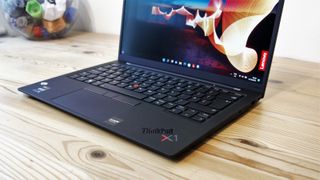
Including these ports makes getting a Thunderbolt docking station or hub a practical necessity with this machine. In the overall scheme of things, it won’t break the bank, but it will enable the X1 Carbon to seamlessly connect to many devices and services, along with charging, through a single cable.
The other feature worthy of mention is the 5G option, an extra that needs to be specified at the time of ordering. Due to the global variations of this technology, different 5G/4G LTE modems are available in regional SKUs, and it may be that a machine bought in one region won’t work on an international trip with these WWAN services in another.
That’s not something Lenovo can easily do anything about, but it is worth being aware that regional compatibility on this point isn’t guaranteed.
- Features: 4 / 5
Lenovo ThinkPad X1 Carbon Gen 10: Performance

- Great performance overall
- A laptop with a desktop NVMe drive
Here's how the Lenovo ThinkPad X1 Carbon Gen 10 (2022) scored in our suite of benchmark tests:
3DMark Wild Life:14,915; Fire Strike: 4,803; Time Spy: 1,847 Cinebench R23 CPU: 1577(single-core); 6,869 (multi-core)
GeekBench 5: 1,518 (single-core); 7,664 (multi-core), 19,961 (OpenCL)
CrystalDiskMark: Sequential Read: 6,465MB/s; Sequential Write: 4,910MB/s
PCMark 10: 5,083 points
PCMark 10 Battery Life (Modern Life): 7 hours and 12 minutes
Windows Experience Index: 8.4
When interpreting benchmarks, it's essential to realise that multiple different components within the system influence the results. And depending on how they interact with each other can have a dramatic impact on the final scores.
At the heart of this system is the Intel Core i7-1260P Processor with 12 Cores and 16 Threads that colours everything else connected to it.
What’s evident is that the Core i7-1260P can be very fast, especially in respect of multi-core operations, but how it runs on a single-core problem can vary.
For those that want even more power, in some regions, the available SKUs offer even higher specification processors, including vPro models.
The issue we encountered testing the X1 Carbon is that once the machine is on battery power, the system appears to want to use efficient E-cores to conserve battery life, reducing performance. When it’s connected to mains power, it unleashes the P-cores for performance. Or that’s the theory. Because sometimes, for whatever reason, it gets its priorities mixed up and ends up with P-cores eating the battery life.
It is possible to tweak the settings to get a more optimal balance, but by default, the X1 Carbon is more inclined to speed than anything else.
Other than the terrific number of threads this machine can cope with, there are two other highlights to the performance profile; the GPU and the NVMe SSD.
Here at Tech Radar Pro, we’ve highlighted how abysmal the Intel UHD Graphics GPU performance is for modern computing and its long overdue replacement. This machine uses a version of the Intel Iris Xe Graphics, which is a step up from the UHD, although not anything that would concern a discrete GPU maker.
That makes the 3DMark and Windows Experience scores higher, but not to the level where it might make the X1 Carbon interesting to those gaming or rendering video.
I guess better than rubbish is still technically better, even if it doesn’t address the core issues regarding its suitability for modern PC use.
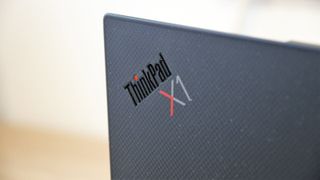
Where this system isn’t flattering itself is the NVMe drive Lenovo installed in it. Recently we’ve seen some nasty NVMe drives appearing in laptops that could barely achieve faster than SATA write speeds, but the one in the X1 Carbon is as good as anything on the PC desktop.
Read performance of nearly 6,500Mb/s and write speeds close to 5,000MB/s is terrific, and these results can only be achieved using the bandwidth of PCIe 4.0 lanes.
The only caveat to using this drive is that it will consume more power than a typical PCIe 3.0 drive to achieve those blinding speeds.
- Performance: 5 / 5
Lenovo ThinkPad X1 Carbon Gen 10: Battery
- 7 hours isn’t enough
As we’ve already mentioned, the processor in this machine has an issue with being optimised for performance over battery life.
When you throw into that mix the Iris Xe graphics and a PCIe 4.0 NVMe drive then the demands on the battery are much more than the Gen 9 machine it replaces.
Using the PCMark 10 Battery Life (Modern Life) test, we achieved 7 hours and 12 minutes on a full charge, not quite a working day. With comfort breaks and occasional phone calls, that might translate into a working day, assuming you’re not working overtime or doing anything demanding.
On the face of it, the 57Whrs 4-cell Lithium-ion battery installed in it should have been enough to get across the working day line easily, but with this CPU, GPU and NVMe drive, it’s borderline.
At this price, a proprietary PSU isn’t acceptable in a machine with dual Thunderbolt ports, and thankfully it comes with a 65W AC Adaptor for USB-C.
Using this port instead of one of the horrible pin-barrel varieties enables any USB-C PSU of 65W or better to charge the X1 Carbon and for power to be shared from it to other USB-C devices with a simple cable, like those phones that aren’t made by Apple.
The battery capacity should have been more, but keeping the Carbon X1 thin and light created a compromise that isn’t successfully resolved in this version.
- Battery: 3 / 5
There are many things to like in the X1 Carbon, especially if you have access to mains power and a Thunderbolt hub connecting a larger display, keyboard and network services.
For those users, this is a lightweight and powerful platform that delivers desktop-like levels of performance in a classic form factor.
However, it isn’t ideal for those on the road without access to recharging, and it comes at a price that might elevate the expenditure sign-off.
If it was a bit cheaper and the battery lasted another hour or more, the X1 Carbon Gen 10 would be a force to reckon with.
Lenovo ThinkPad X1 Carbon Gen 10: Report card
| Value | Expensive for the Core i7 level SKUs, and hardly cheap for the Core i5 options. | 3 / 5 |
| Design | The very definition of a ThinkPad, built with the latest Intel silicon and aircraft-level engineering | 4 / 5 |
| Features | An OLED screen, Thunderbolt 4 ports, and integrated 5G/4G LTE are all wonderful to have. | 4 / 5 |
| Performance | As a computing platform, the silicon in this one is excellent, and when combined with Gen 4 NVMe storage and plenty of RAM, it flies. | 5 / 5 |
| Battery | You might hope that 57Whrs would take you further | 3 / 5 |
| Total | A great Ultrabook if you can afford one. | 4 / 5 |
Should you buy a Lenovo ThinkPad X1 Carbon Gen 10?
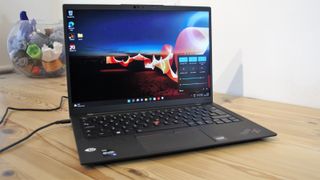
Buy it if...
You want portability and power
The combination of carbon fibre and magnesium construction delivers a very lightweight system that has plenty of performance for presentations and running apps.
This system isn’t tiresome to carry around.
Like a ThinkPad
The styling and features of the ThinkPad are mildly addictive, and often customers will return for precisely those. It’s not to everyone’s taste, but it's been highly successful for three or more decades.
Flexibility is important
Buying hardware than then not being able to repurpose it can be very annoying, but there is enough performance and capabilities here that shouldn’t be an issue.
Combined with a Thunderbolt dock, the Carbon X1 is your flexible friend.
Don't buy it if...
It’s your money
As nice as this system is, you are paying for every inch of carbon fibre, OLED, and magnesium. Those interested in value for money should look elsewhere because this equipment ranges from pricey to disturbingly expensive.
It’s purely for Office apps
The number of cores and threads that this system can cope with makes it complete overkill for most office jobs. The Carbon X1 is a desktop replacement and can cope with some intense tasks easily. If you don’t need this power, then scale back or choose something else.
Battery life is critical
The power envelope of the Carbon X1 isn’t bad, but it isn’t amazing either. For those that often see a long day on the road without mains power or car charging, seven or slightly more hours of battery just might not be enough.
Also consider
Dell XPS 15 (2022)
A big screen, excellent performance and discrete graphics make this one of the best Ultrabook designs on the market. Sadly, it suffers from the same issue as the X1 Carbon, in that the top-spec machines are expensive.
Check out our Dell XPS 15 (2022) review
HP Elite Dragonfly G2
An 11th Gen CPU design that is highly portable and comes with a very high-quality screen. However, all the USB ports are on one side, and it isn’t the cheapest option. Hopefully, when the 12th Gen silicon refresh comes along, these might become cheaper.
Read our full HP Elite Dragonfly G2 review
Mark is an expert on 3D printers, drones and phones. He also covers storage, including SSDs, NAS drives and portable hard drives. He started writing in 1986 and has contributed to MicroMart, PC Format, 3D World, among others.
